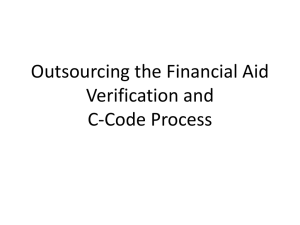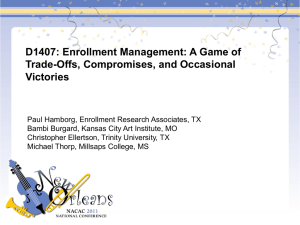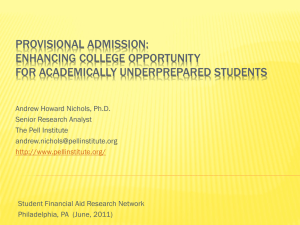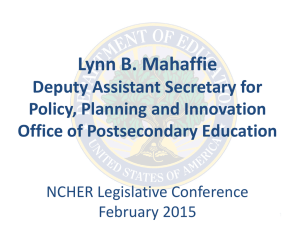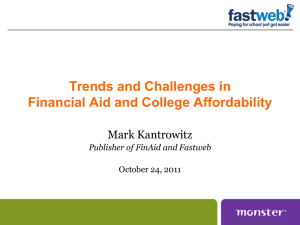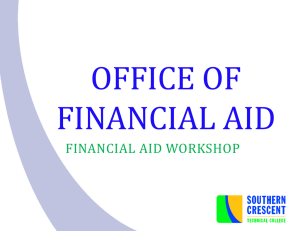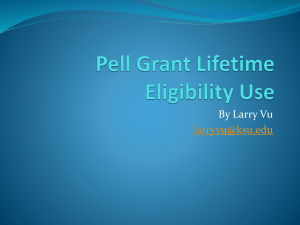Assessing the Impact of Financial Aid on Student Success
advertisement
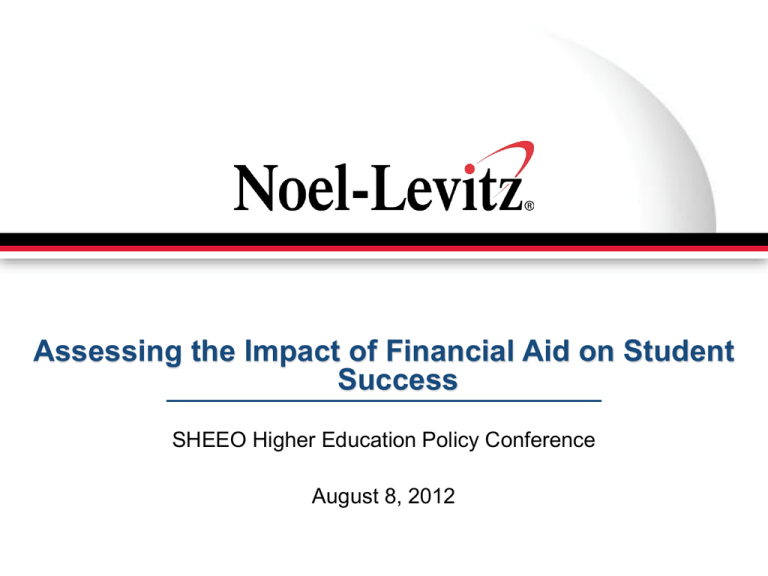
Assessing the Impact of Financial Aid on Student Success SHEEO Higher Education Policy Conference August 8, 2012 Objectives for our time together 1 Project Overview 2 Louisiana Findings 3 Oklahoma Findings 4 Discussion About the research partnership Two papers have already been released on LA findings Research Questions • How does the level and mix of financial assistance affect retention and completion among Pell Grant recipients? • Can we observe differences in the retention of Pell Grant recipients versus students in other financial classifications (needy non-Pell recipients and no-need students)? Research Questions • Can we identify flex points in the size and composition of financial aid awards where additional dollars yield diminishing or no returns? Can we help the state’s package aid more efficiently by eliminating “overpayment” to some students and shifting that money to students who might otherwise be inclined to drop out? Research Questions • How do state-based aid programs (TOPS, Go Grant, OK Promise and OTAG) interact with the Pell Grant and with want impact on student retention and completion? • What is the best use of the state’s financial aid investments? Key Project Outcomes for the LA Regents and OSRHE • • • • Conduct custom policy research Assist in advancing policy changes as needed Develop report shells based on findings Develop internal capacity to analyze and monitor data in the future Louisiana findings High school GPA* was the strongest academic preparation variable 100.0% Retention Rate 90.0% 87.0% 80.0% 79.0% 70.0% 70.0% 60.0% 50.0% 55.0% 40.0% < 3.00 3.00 - 3.49 3.50 - 3.74 High School GPA * 2,817 records (out of 37,251) were missing a high school GPA (they retained at 58%) 3.75 - 4.00 Once we control for high school GPA*, Pell recipients retain as well as other students with demonstrated financial need No Pell Pell Retention Rate 100.0% 90.0% 80.0% 70.0% 60.0% 50.0% 40.0% < 3.00 3.00 - 3.49 3.50 - 3.74 High School GPA Range 3.75 - 4.00 Among Pell recipients, as the percentage of need met with gift aid increases so does student retention Retention Rate by % Need Met w/Gift, All Records All Records % Need Met with Gift <30 40 50 60 70 80+ Grand Total Retain 1301 1449 1622 1308 1136 1958 8774 Did Not Retain 1363 1103 936 537 408 462 4809 Total 2664 2552 2558 1845 1544 2420 13583 Retention Rate 48.8% 56.8% 63.4% 70.9% 73.6% 80.9% 64.6% 100.0% 90.0% 80.0% 70.0% 60.0% 50.0% Chi-Square Results: df 5 value 727.1 p-value <.0001 40.0% 30.0% <30 40 50 60 Increasing the gift percentage from less than 30 percent to 60 percent corresponds to a 22 percentage point increase in the retention rate, while increasing the percentage of need met with gift aid from 60 percent to 70 percent increases retention by only 3 points. 70 80+ Adding the Go Grant alone increases the percentage of need met with gift aid by 14 percentage points and provides a 5.6 percentage point improvement in retention Need Met with Gift Aid 80.0% 73.3% 70.0% 60.0% 53.8% 59.4% 73.9%74.9% 63.0% 47.5% 50.0% 40.0% Retention Rate 34.0% 30.0% 20.0% 10.0% 0.0% Pell Only Pell + GO All pairwise comparisons of means are significant except for retention rate between Pell+TOPS and Pell+GO+TOPS Pell + TOPS Pell + GO + TOPS Oklahoma findings High school GPA was used as the control for academic preparation because it entered a predictive model we built on the data set Relative Strength of Model Variables Percent Need Met with Gift High School GPA 7.6% 7.7% 39.3% EFC>0 Flag 17.1% Distance from Campus 28.2% Institution Code Note: In our 2010 work, we used ACT composite as the control variable, but that was not based on a model Pell Grant recipients retain as well as students in other categories Table 3: Fall-to-Fall Same School Retention by HSGPA Fall 2006, Fall 2007, Fall 2008 HSGPA All Pell Needy, no Range Students Recipients Pell Grant < 3.00 47% 51% 45% 3.00 - 3.49 61% 62% 60% 3.50 - 3.74 71% 70% 73% 3.75 - 4.00 81% 82% 78% GPA missing 53% 54% 57% 62% 62% 63% Total This parity in performance is encouraging given the vast difference in family income between the Pell students ( approx. $20,000) and students with demonstrated financial need without Pell Grants (approx. $56,000) There is a relationship between the percentage of need met with gift aid and retention among Pell recipients 2.86 and below 2.87 to 3.35 3.36 to 3.63 3.64 and above 100.0 90.0 80.0 70.0 Retention Rate 60.0 50.0 40.0 30.0 20.0 10.0 0.0 Less than 28% 29% to 50% 51% to 79% % of Need Met with Gift 80% and above Retention rates by combinations of Pell Grants and Promise/OTAG Pell Grant Only, No Promise or OTAG Pell, Promise and OTAG Pell and Promise, No OTAG Total (All Pell Recipients) Pell and OTAG, No Promise 90.0% 80.0% 70.0% 60.0% 50.0% 40.0% 30.0% <3.0 3.0-3.49 3.5-3.74 >3.74 Total Questions Questions and Discussion
